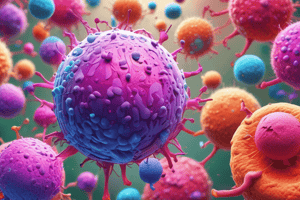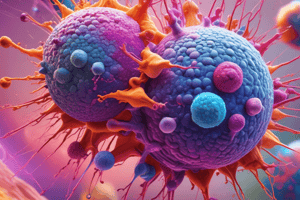Podcast
Questions and Answers
What is the primary cause of Graft-Versus-Host Disease?
What is the primary cause of Graft-Versus-Host Disease?
- Immune system failure of the host
- Incompatibility of blood types
- Failure to match HLA/MHC haplotypes
- Passenger leukocytes attacking host tissue (correct)
Which method is currently used to match the HLA/MHC haplotypes of donor and recipient?
Which method is currently used to match the HLA/MHC haplotypes of donor and recipient?
- Immunohistochemical staining
- Flow-Cytometry based methods (correct)
- Direct observation of T cell activity
- Mixed-Leukocyte Culture
Why do repeat transplants have a lower chance of success?
Why do repeat transplants have a lower chance of success?
- Greater risk of infectious complications
- Transplant procedures become more complex with each attempt
- Recipient is older and weaker
- Similar to a ‘memory’ response from prior exposure (correct)
What was the original primary immunosuppressive drug used to prevent graft rejection?
What was the original primary immunosuppressive drug used to prevent graft rejection?
What is a potential benefit of induction of graft tolerance strategies?
What is a potential benefit of induction of graft tolerance strategies?
What is the primary function of an adjuvant in vaccines?
What is the primary function of an adjuvant in vaccines?
Which adjuvant is most commonly used in human vaccines?
Which adjuvant is most commonly used in human vaccines?
What defines the 'perfect' adjuvant?
What defines the 'perfect' adjuvant?
What type of immune response does aluminum adjuvant primarily induce?
What type of immune response does aluminum adjuvant primarily induce?
Which of the following adjuvant types is gaining acceptance in human vaccine formulations?
Which of the following adjuvant types is gaining acceptance in human vaccine formulations?
What is a characteristic of Water-in-Oil-in-Water (W/O/W) emulsions?
What is a characteristic of Water-in-Oil-in-Water (W/O/W) emulsions?
What role do PAMPs play in the immune response?
What role do PAMPs play in the immune response?
What type of graft involves tissue transferred between genetically diverse individuals?
What type of graft involves tissue transferred between genetically diverse individuals?
Which type of graft uses tissue from an individual and transplants it to another site on the same person?
Which type of graft uses tissue from an individual and transplants it to another site on the same person?
What triggers the immune response against grafts due to differences in donor and recipient?
What triggers the immune response against grafts due to differences in donor and recipient?
What is the main characteristic of an allograft?
What is the main characteristic of an allograft?
Which process describes the immune system's recognition of foreign MHC molecules as altered self?
Which process describes the immune system's recognition of foreign MHC molecules as altered self?
What may cause chronic rejection in grafts due to minor differences?
What may cause chronic rejection in grafts due to minor differences?
Which of the following is NOT a type of graft mentioned?
Which of the following is NOT a type of graft mentioned?
What type of cells are primarily involved in the rejection of grafts?
What type of cells are primarily involved in the rejection of grafts?
What is a key feature of indirect allorecognition in grafts?
What is a key feature of indirect allorecognition in grafts?
Which graft involves tissues from different species?
Which graft involves tissues from different species?
What is the primary cause of hyperacute rejection in solid organ transplants?
What is the primary cause of hyperacute rejection in solid organ transplants?
Which type of rejection occurs over a period of months or years?
Which type of rejection occurs over a period of months or years?
Which immune cells predominantly infiltrate during acute cellular rejection?
Which immune cells predominantly infiltrate during acute cellular rejection?
What is the mechanism of chronic rejection in solid organ transplants?
What is the mechanism of chronic rejection in solid organ transplants?
What is a characteristic feature of acute humoral rejection?
What is a characteristic feature of acute humoral rejection?
Which type of rejection does not involve any infiltrating cells?
Which type of rejection does not involve any infiltrating cells?
In terms of treatment, hyperacute rejection requires what type of approach?
In terms of treatment, hyperacute rejection requires what type of approach?
Which of the following is a target on the donor cell in acute rejection?
Which of the following is a target on the donor cell in acute rejection?
What causes damage to tissue during solid organ transplantation?
What causes damage to tissue during solid organ transplantation?
Which of the following is associated with the presence of C4d?
Which of the following is associated with the presence of C4d?
What is the primary function of saponins in vaccine formulations?
What is the primary function of saponins in vaccine formulations?
Which of the following statements about vaccine side effects is correct?
Which of the following statements about vaccine side effects is correct?
Which delivery vehicle is made from viral membranes?
Which delivery vehicle is made from viral membranes?
What is a known urban legend regarding the DTaP vaccine?
What is a known urban legend regarding the DTaP vaccine?
What type of vaccine targets specific diseases like HIV and malaria for prevention?
What type of vaccine targets specific diseases like HIV and malaria for prevention?
What is the term for a graft between genetically identical individuals?
What is the term for a graft between genetically identical individuals?
What potential issue can arise from stem cell transplantation?
What potential issue can arise from stem cell transplantation?
Which type of vaccine is created using genetic material from the pathogen?
Which type of vaccine is created using genetic material from the pathogen?
What is one of the primary goals of pre-therapy screening in transplantation?
What is one of the primary goals of pre-therapy screening in transplantation?
Flashcards
Adjuvant
Adjuvant
A substance added to a vaccine to enhance the immune response to the vaccine's antigens.
Immunogenicity
Immunogenicity
The ability of a vaccine antigen to induce an immune response.
Delivery Strategy
Delivery Strategy
How an adjuvant helps a vaccine antigen reach the immune cells responsible for generating an immune response.
Immune Potentiator Strategy
Immune Potentiator Strategy
Signup and view all the flashcards
Aluminum Adjuvants
Aluminum Adjuvants
Signup and view all the flashcards
Lipid/Oil Emulsions
Lipid/Oil Emulsions
Signup and view all the flashcards
Water-in-Oil-in-Water (W/O/W) Emulsion
Water-in-Oil-in-Water (W/O/W) Emulsion
Signup and view all the flashcards
Graft-versus-Host Disease
Graft-versus-Host Disease
Signup and view all the flashcards
Passenger Leukocytes
Passenger Leukocytes
Signup and view all the flashcards
HLA/MHC Haplotype Matching
HLA/MHC Haplotype Matching
Signup and view all the flashcards
Immunosuppressive Therapy
Immunosuppressive Therapy
Signup and view all the flashcards
Induction of Graft Tolerance
Induction of Graft Tolerance
Signup and view all the flashcards
Coli Enterotoxin (LT)
Coli Enterotoxin (LT)
Signup and view all the flashcards
Cholera Toxin (CT)
Cholera Toxin (CT)
Signup and view all the flashcards
Saponins
Saponins
Signup and view all the flashcards
Liposomes
Liposomes
Signup and view all the flashcards
ISCOMS
ISCOMS
Signup and view all the flashcards
Virosomes
Virosomes
Signup and view all the flashcards
Virus-like Particles (VLPs)
Virus-like Particles (VLPs)
Signup and view all the flashcards
Vaccine Side Effects
Vaccine Side Effects
Signup and view all the flashcards
VAERS
VAERS
Signup and view all the flashcards
Solid Organ Transplantation trauma
Solid Organ Transplantation trauma
Signup and view all the flashcards
DAMPs and PAMPs
DAMPs and PAMPs
Signup and view all the flashcards
Hyperacute Rejection
Hyperacute Rejection
Signup and view all the flashcards
Acute Rejection
Acute Rejection
Signup and view all the flashcards
Chronic Rejection
Chronic Rejection
Signup and view all the flashcards
Allo MHC
Allo MHC
Signup and view all the flashcards
Passenger Antigens
Passenger Antigens
Signup and view all the flashcards
CTL
CTL
Signup and view all the flashcards
Pre-formed Antibodies
Pre-formed Antibodies
Signup and view all the flashcards
Germinal Center Formation
Germinal Center Formation
Signup and view all the flashcards
Allogeneic Graft
Allogeneic Graft
Signup and view all the flashcards
Autograft
Autograft
Signup and view all the flashcards
Isograft
Isograft
Signup and view all the flashcards
Allograft
Allograft
Signup and view all the flashcards
Xenograft
Xenograft
Signup and view all the flashcards
MHC Haplotype
MHC Haplotype
Signup and view all the flashcards
Direct Allorecognition
Direct Allorecognition
Signup and view all the flashcards
Indirect Allorecognition
Indirect Allorecognition
Signup and view all the flashcards
Minor Histocompatibility Antigens (MiHA)
Minor Histocompatibility Antigens (MiHA)
Signup and view all the flashcards
Study Notes
Adjuvant
- An agent added to a vaccine to enhance immune responses against vaccine antigens
- Used for over 80 years
- Technology is constantly evolving due to advances in immunology and chemistry
- Recombinant proteins and peptides can be poorly immunogenic
Different Adjuvants - Different Strategies
- Delivery: Carriers stabilize vaccine antigens, allowing them to remain present for extended periods.
- Immune potentiator: Exerts a direct stimulatory effect on immune cells, initiating the immune response through the activation of innate immunity. A danger signal is involved.
The "Perfect" Adjuvant
- A perfect adjuvant involves both delivery and immune potentiator strategies
- Delivery enhances antigen reaching immune cells
- Immune potentiator directly activates these cells
- The goal is to activate only necessary immune response elements for protection, avoiding generalized immune activation, or an "effective and safe" response.
Alums
- Primarily aluminum adjuvants
- Used extensively in veterinary vaccines.
- Common adjuvant in human vaccines
- Induces strong Th2 responses
- Examples:
- Aluminum hydroxide
- Aluminum potassium sulfate (often called "Alum")
- Used in many toxoid formulations (e.g., Clostridial vaccines)
Lipid/Oil Emulsions
- Detergent-stabilized emulsions of oil and water
- Precise mode of action is not entirely understood
- Depot effect
- Induces MHC responses
- Primarily used in veterinary vaccines
- Gaining acceptance in human vaccine formulations (e.g., MF59)
- Three basic forms:
- Oil in water (O/W)
- Water in oil (W/O) (Freund's)
- Water in oil in water (W/O/W)
Oil Based Adjuvants Used in Veterinary Vaccines
- Water-in-oil emulsions (W/O): Antigen-containing water droplets within a continuous oil phase.
- Oil-in-water emulsions (O/W): Emulsified oil droplets within a continuous antigen-containing aqueous phase.
- Water-in-oil-in-water emulsions (W/O/W): Antigen-containing water droplets within larger oil droplets, dispersed in a continuous antigen-containing water phase
W/O/W Adjuvant System
- Diagram showing oil phase, aqueous phase and antigens
- Surfactant is indicated
PRR and Other Ligands
- Microbial Derivatives:
- PAMPs induce Th1 response
- LPS interacts with APCs, releasing pro-inflammatory cytokines
- CpG is bacterial DNA
- Mucosal:
- Heat-labile E. coli enterotoxin (LT)
- Cholera toxin (CT)
- Saponins:
- Plant derivative
- Primary function is cytokine induction
- Potentiates Th1 response (IL-2, IFN-γ, IgG2a).
- Can be toxic to certain species (e.g., humans, mice)
- Commonly used in veterinary vaccines
Delivery Vehicles
- Liposomes: Membrane-bound phospholipid vesicles, trapping or incorporating antigen in their lumen or membrane
- Increased antigen uptake by antigen-presenting cells (APCs)
- ISCOMs (Immune Stimulating Complexes): Liposomes containing saponin
- Virosomes: Liposomes prepared from viral membranes
- Virus-like Particles (VLPs): 30-90 nm self-assembled virus proteins with a nucleic acid or lipid genome
Vaccine Side Effects
- Typically include redness/pain at injection site, sneezing/nasal congestion (intranasal), fatigue/headaches
- Monitor adverse reactions using the Vaccine Adverse Events Reporting System (VAERS)
- Urban Legends:
- DTaP associated with sudden infant death syndrome (SIDS)
- HBV associated with multiple sclerosis
- Inactivated poliovirus vaccine (IPV) contamination with SV40 associated with cancer
- Polio vaccine associated with HIV
- Lyme disease vaccine associated with arthritis
Future Vaccines
- Prophylactic: HIV, Ebola, Hepatitis C virus, malaria
- Therapeutic: Cancer, dendritic cell culture, autoimmune/allergy, domestic animal castration
Summary
- Whole organism (modified live, inactivated)
- Subunit
- Recombinant Live
- DNA
- Adjuvant
- Vaccine Usage
- Vaccine side effect outweigh disease
Types of Vaccines and Their Pros and Cons
- Information on vaccine types, their features, advantages, and disadvantages
Transplantation
- The Nature of Transplantation:
- Molecular basis of graft rejection
- Allo/auto antigens, minor histocompatibility antigens
- Solid organ transplants
- Graft rejection, graft-versus-host disease
- Therapy:
- Pre-therapy screening
- Post-transplant drugs
- Tolerance
- Stem cell transplantation
- Use
- Rejection
- Graft-versus-host
- Transfusions
Terminology
- Syngeneic: Grafts between genetically identical individuals
- Allogeneic: Grafts between genetically diverse individuals
- Autograft: Self-tissue transplanted to a different site (e.g., skin grafts in burns)
- Isograft: Tissue transferred between genetically identical individuals (mostly experimental)
- Allograft: Tissue transferred between genetically different individuals of the same species (most common)
- Xenograft: Tissue transferred between different species (experimental)
Tissue Antigens
- Graft rejection is due to differences in HLA/MHC haplotypes between recipient and donor.
- Rejection involves both T and B cell responses
Molecular Basis of Graft Rejection
- Immune response against grafts follows general immune response rules and processes
- Recognition occurs via MHC-mediated recognition of “altered self” or disparate MHC antigens (allorecognition), or through recognition of minor histocompatibility antigens
Direct Recognition
- T-cell positive/negative selection ability to recognize self-MHC at a certain level
- Peptide addition specifies recognition for normal tissues (altered-self)
- Foreign MHC molecules can resemble self but be different enough to trigger T-cell activation
- Passenger leukocytes in grafts can stimulate recipient T cells.
Indirect Allorecognition
- More direct stimulation
- Foreign peptides are the result of antigens shed by grafts (e.g., dying cells)
- Self-proteins won't be recognized
- Some all-MHC proteins can produce immunostimulatory T cell peptides
Minor Histocompatibility Antigens
- Minor histocompatibility antigens (MiHAs) typically cause chronic rejection or a slower response.
- Differences in allelic coding for similar proteins between donor and recipient can cause an immune response.
- Example: the protein coding for blue eyes on the graft could provoke a response in a recipient with brown eyes.
Solid Organ Transplantation
- Note that transplantation is naturally a traumatic experience, damaging tissues and endothelium.
- This damages tissue, endothelium, blood vessels, activating DAMPs and PAMPs on the graft, triggering innate immune responses.
Adaptive Immune Responses
- Pre-formed antibodies can directly kill graft tissue (hyperacute rejection).
- Passenger antigens and leukocytes are transported to lymph nodes, initiating germinal center formation and cellular activation.
- CTLs, antibodies and helper T cells produced against the graft can travel to and destroy affected tissue as a foreign body.
Terminology Cont'd
- Hyperacute rejection: Occurs in minutes due to the existence of preformed antibodies
- Acute rejection: Occurs within days/weeks due to a normal immune response.
- Chronic rejection: Occurs over months/years; mechanisms are not entirely understood.
Types of Rejection of Solid Organ Transplants
- Summary table of rejection types, including time, targets, mechanisms, cells infiltrating, fibrosis and treatments.
Graft-Versus-Host Disease
- Occurs when graft leukocytes fail to recognize the recipient's tissues (leading to an immune attack on host tissues).
- Immune processes involved are as expected
- Dendritic cells and T cells within the transplanted organ are capable of proliferating and attacking host tissues.
- More common with transplants of immune tissues (e.g., blood, stem cells) compared to solid organs.
Minimizing Graft Rejection
- Matching donor and recipient HLA/MHC haplotypes is the most effective way to prevent rejection
- In the past, this was done with Mixed Lymphocyte Cultures (MLCs) testing
- Flow cytometry is now commonly used to determine donor and recipient HLA allele-specific leukocytes
Screening for Pre-existing Antibodies
- Determining if pre-existing antibodies in the recipient could affect graft success
- Repeat transplants have lower success rates due to memory response
- Screening can use solid-phase or flow cytometry analysis to look for recipient immune responses to donor cells
Immunosuppressive Therapy
- Immunosuppressive medications generally "turn off" the recipient's immune response, preventing their immune cells from attacking the implanted organ.
- Cyclosporin A initially was commonly used to block IL-2-dependent proliferation, but there are more modern analogs with fewer side effects.
Induction of Graft Tolerance
- Highly targeted methods are being developed to limit transplant rejection by inducing immunological tolerance.
- Goal is to convince the immune system that the new organ is self so the rejection response does not happen.
- Method involves selectively inhibiting or stimulating regulatory T-cells.
Hematopoietic Stem Cells
- Hematopoietic stem cell transplantation (HSCT) is used in treating various conditions.
- Radiation/chemotherapy used in HSCT destroys immune cells in the body.
- Can be used in the effort to treat autoimmune disease or to enhance organ transplant acceptance
Blood Transfusions
- Blood transfusions, one of the first forms of organ transplantation, require careful ABO blood typing in order to prevent immune rejection due to pre-existing antibodies directed against donor blood cells.
- If pre-existing recipient antibodies are not accounted for, the donor cells may be attacked, leading to toxicity and anemia.
Blood Group Antigens/Antibodies
- Table showing blood types, genotypes, RBC antigens, antibodies and compatible donors
Next (final) lecture
- Autoimmunity
Studying That Suits You
Use AI to generate personalized quizzes and flashcards to suit your learning preferences.




